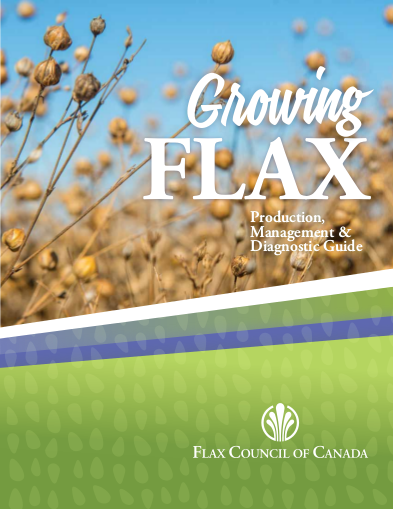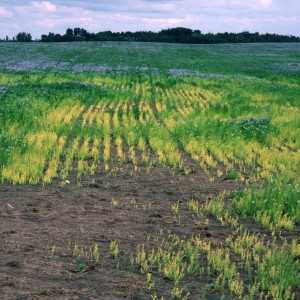Chapter 9: Environmental Disorders
Chlorosis and Top Dieback
Chapter 9 – PDF version
Download the PDF version of ‘Chapter 9: Environmental Disorders’.
These disorders are associated with an imbalance of nutrient elements in the plant. Such disorders are often found in soils high in lime and are most severe under high soil-moisture conditions. Leaf chlorosis may also occur in flax on water-logged soils.
Symptoms: Under high soil-moisture conditions, plants become yellow, which may or may not be accompanied by dieback of the terminal bud and the development of basal branching (Photo 9-1 and Photo 9-2).
Control: Choose cultivars such as AC Emerson, which are more tolerant to conditions causing the disorder (see Varieties). Since chlorotic plants are more sensitive to herbicides, care must be taken to apply herbicides under conditions that result in least injury.
Heat and Frost Canker
Cankers are caused by very high or freezing temperatures when the crop is in early stages of growth. While the damage is commonly inconspicuous, stands may be reduced by as much as 50%. Damage is usually most severe in thin stands on light soils (Photo 9-3). Low spots are more conducive to frost canker.
Symptoms: Frost cankers are similar to heat cankers in appearance. Affected plants are girdled at or near the soil line (Photo 9-4). The area below the constriction is usually thin and dry, while that above it consists of scar tissue which may appear swollen, rough and cracked. The scar tissue is brittle, and affected plants usually fall over. Less severely damaged plants may produce new shoots which grow to maturity, or they may topple over later in the season, turn yellow and die.
Control: The incidence of heat and frost canker is reduced by following recommended seeding practices to ensure good, vigorous stands. The practice of early seeding at a high rate has been shown to be effective on soils where these disorders can be a problem.
Herbicide Injury
Herbicide injury in flax can be grouped into three categories:
- Incorrect application or
- Herbicide residues in the soil
- Herbicide drift.
Incorrect application of herbicides
Flax has natural tolerance to many herbicides and although there are several herbicides that will cause injury to flax, they seldom kill the plant. Flax plants that have been injured from a herbicide treatment often show only slight symptoms. Injury from herbicides usually results in delays in flowering and/or maturity.
In addition to these general symptoms, there are some specific symptoms that can occur in flax with certain herbicides.
Authority®
- There is some risk of injury to flax from application of this herbicide on low organic matter soils, coarse textured soils and/or soils with a pH greater than 8, particularly if above-normal rainfall occurs within two weeks of application. Injury manifests as a thin stand as injured flax seedlings fail to emerge.
Bromoxynil/MCPA
- Bromoxynil/MCPA is commonly used to control broadleaf weeds in flax. Bromoxynil/MCPA should not be applied to flax crops if the daytime temperature exceeds 27°C (80°F) within two days prior to, or after the application. Under these high heat conditions, bromoxynil/MCPA causes height reductions and browning of the leaves, giving the flax plant a scorched appearance (Photo 9-5).
- Flax that recovers from this injury will have delayed flowering and maturity. Spraying in the evening may reduce the risk of flax injury. This injury can occur when bromoxynil/MCPA is applied alone or in tank mix with other herbicides.
MCPA
- MCPA is often used to control certain broadleaf weeds in flax. MCPA should not be applied to flax under hot or humid conditions. Flax treated with MCPA under hot or humid conditions will have a wilty appearance with bending in the stem and some height reduction. These symptoms result in delays in flowering and maturity. Applications of MCPA are preferably applied to flax prior to the 10 cm (4 in.) height.
Trifluralin
- Trifluralin herbicides for use in flax must be applied in the fall before the crop is sown. When seeding into ground treated with trifluralin, it is important to seed shallow to avoid crop injury. If flax is sown deep into the trifluralin-treated soil zone, reduced emergence and poor growth occur –resulting in a thin plant stand. Plants emerging from deep in the trifluralin zone will have swollen roots and will suffer from root pruning and therefore will be short, develop very slowly and have reduced yields.
Unregistered herbicides
Since flax has relatively good tolerance to many broadleaf herbicides, it has occasionally been treated with unregistered herbicides. However, as an increasing percentage of the flax crop is being utilized as a food crop, the use of herbicides not registered for flax is of growing concern. These herbicides usually cause delays in flowering and maturity, along with reduced yields.
Herbicide soil residues
Flax is susceptible to the residues from only a few herbicides. For specific information on the soil residual properties of individual herbicides, refer to the herbicide label or provincial recommendations.
Flax plants affected by herbicide residues in the soil are often stunted and have yellowing at the growing point (Photo 9-6). The severity of the injury to flax depends on when the herbicide was applied, the rate at which it was applied, and the soil type. To avoid the risk of injury from herbicide residues in the soil, carefully follow the recropping intervals identified on herbicide labels.
9-1 – Flax chlorosis general view
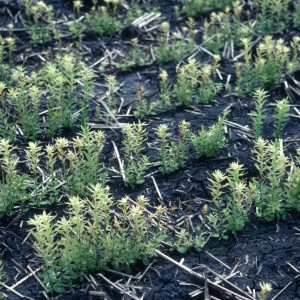
9-2 – Flax chlorosis

9-3 – Flax Heat and frost Canker
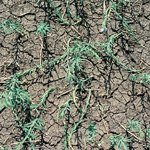
9-4 – Heat and frost canker; plants have toppled over
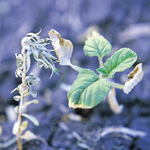
9-5 – Applying herbicide when the daytime temperature was too high, caused this bromoxynil/MCPA injury on flax
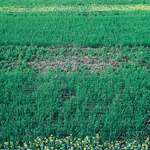
9-6 – Flax plants affected by chlorsulfuron residues (Group 2) in the soil, one year after the herbicide was applied. Note the thin and stunted flax stand.
Herbicide drift
Herbicide drift occurs when herbicides are applied in windy conditions, or when there is no wind and temperature inversions occur. Since flax shows good tolerance to many herbicides, there are only a few which commonly cause drift concerns. Glyphosate applied in the spring to fields adjacent to flax under drift-sensitive conditions can cause serious injury to flax. The extent of damage is dependent on the distance that the wind has carried the drift and the rate of herbicide used. Flax affected by glyphosate has a chlorotic growing point, and with higher rates the leaves may develop necrotic (dried brown) areas. At very low doses, glyphosate drift can cause a characteristic twist or kink in the stem of the flax plant that occurs at the location of the growing point at the time of exposure to glyphosate. In this case, no chlorosis or necrosis are observed.
Photos are courtesy of AAFC, and remain property of AAFC.
Production Tip
Choose a well-drained soil with no herbicide residue.

